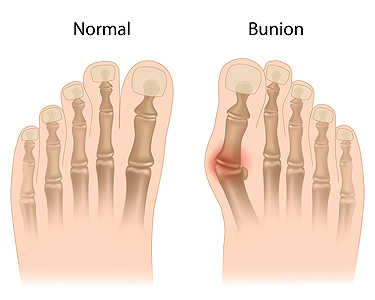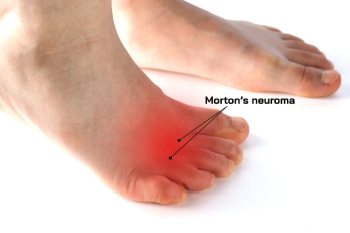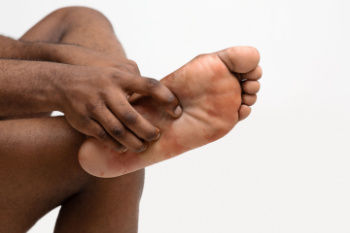Items filtered by date: August 2024
Definiton and Risk Factors for Bunions

Bunions are a foot deformity characterized by a noticeable bump at the base of the big toe, where it angles towards the second toe. This deformity results from an imbalance in the bones and ligaments of the foot. Symptomscan typically include localized pain, swelling, and redness at the site of the bunion. The affected toe may also become stiff, making it difficult to wear shoes comfortably or walk without discomfort. Several factors contribute to the development of bunions. Genetics play a significant role. If bunions run in your family, you are more likely to develop them. Wearing tight, narrow shoes can worsen the condition by putting pressure on the toes. Other contributing factors can include arthritis and structural abnormalities in the foot. If you are experiencing some of these symptoms, it is suggested that you schedule an appointment with a podiatrist who can diagnose and offer a comprehensive treatment plan.
If you are suffering from bunions, contact Dr. Odin De Los Reyes of Connecticut. Our doctor can provide the care you need to keep you pain-free and on your feet.
What Is a Bunion?
A bunion is formed of swollen tissue or an enlargement of boney growth, usually located at the base joint of the toe that connects to the foot. The swelling occurs due to the bones in the big toe shifting inward, which impacts the other toes of the foot. This causes the area around the base of the big toe to become inflamed and painful.
Why Do Bunions Form?
Genetics – Susceptibility to bunions are often hereditary
Stress on the feet – Poorly fitted and uncomfortable footwear that places stress on feet, such as heels, can worsen existing bunions
How Are Bunions Diagnosed?
Doctors often perform two tests – blood tests and x-rays – when trying to diagnose bunions, especially in the early stages of development. Blood tests help determine if the foot pain is being caused by something else, such as arthritis, while x-rays provide a clear picture of your bone structure to your doctor.
How Are Bunions Treated?
- Refrain from wearing heels or similar shoes that cause discomfort
- Select wider shoes that can provide more comfort and reduce pain
- Anti-inflammatory and pain management drugs
- Orthotics or foot inserts
- Surgery
If you have any questions, please feel free to contact our offices located in Southbury and Farmington, CT . We offer the newest diagnostic and treatment technologies for all your foot care needs.
What Is Morton’s Neuroma?

Morton's neuroma is a painful condition affecting the ball of the foot, typically between the third and fourth toes. It involves the thickening of tissue surrounding one of the nerves leading to the toes, causing sharp, burning pain, numbness, or a sensation of something being lodged in the foot. To diagnose Morton's neuroma, a podiatrist will perform a physical examination, checking for tenderness and a palpable mass between the toes. Imaging tests like ultrasound or MRI scans may be used for confirmation. Treatment options include modifying footwear to reduce pressure on the affected area, using orthotic inserts, and administering corticosteroid injections to reduce inflammation. In severe cases, surgical removal of the affected nerve may be necessary to alleviate symptoms and restore normal foot function. If you have pain in the ball of your foot, it is suggested that you schedule an appointment with a podiatrist for a proper diagnosis and treatment plan.
Morton’s neuroma is a very uncomfortable condition to live with. If you think you have Morton’s neuroma, contact Dr. Odin De Los Reyes of Connecticut. Our doctor will attend to all of your foot care needs and answer any of your related questions.
Morton’s Neuroma
Morton's neuroma is a painful foot condition that commonly affects the areas between the second and third or third and fourth toe, although other areas of the foot are also susceptible. Morton’s neuroma is caused by an inflamed nerve in the foot that is being squeezed and aggravated by surrounding bones.
What Increases the Chances of Having Morton’s Neuroma?
- Ill-fitting high heels or shoes that add pressure to the toe or foot
- Jogging, running or any sport that involves constant impact to the foot
- Flat feet, bunions, and any other foot deformities
Morton’s neuroma is a very treatable condition. Orthotics and shoe inserts can often be used to alleviate the pain on the forefront of the feet. In more severe cases, corticosteroids can also be prescribed. In order to figure out the best treatment for your neuroma, it’s recommended to seek the care of a podiatrist who can diagnose your condition and provide different treatment options.
If you have any questions, please feel free to contact our offices located in Southbury and Farmington, CT . We offer the newest diagnostic and treatment technologies for all your foot care needs.
Proper Footwear for Restaurant Workers

Proper footwear is essential for restaurant workers as a way of maintaining health and comfort throughout long shifts. These jobs often involve extended periods of standing and walking on hard surfaces, which can lead to foot, leg, and back pain if the right shoes are not worn. Proper footwear provides necessary support, cushioning, and stability, helping to absorb shock and reduce the risk of injuries such as sprains or stress fractures. Shoes with slip-resistant soles also enhance safety by preventing slips and falls in potentially hazardous kitchen environments. Additionally, wearing well-fitted, supportive shoes can help alleviate common issues like plantar fasciitis and bunions. Investing in high-quality, ergonomic footwear ensures that restaurant workers remain comfortable and protected. If you work in the restaurant industry and have endured a foot injury or have developed chronic foot pain, it is suggested that you speak with a podiatrist. This type of doctor can offer effective treatment options, in addition to guiding you toward wearing appropriate footwear for the job.
While working on the feet, it is important to take the proper care of them. For more information about working on your feet, contact Dr. Odin De Los Reyes from Connecticut. Our doctor will treat your foot and ankle needs.
Working on Your Feet
Standing on your feet for long periods of time can cause stress and pain in your feet. Your whole body may experience change in terms of posture, back pain, bunions, callouses and or plantar warts. There are ways to avoid these conditions with proper foot care, smart choices and correct posture.
Positive Changes
Negative heeled shoe – Choosing this shoe type places the heel slightly lower than the ball of the foot. These are great for overall foot health. Find shoes that fit you correctly.
Go barefoot – Our feet were not designed to be enclosed for all hours of the day. Try to periodically expose your feet to air.
Eliminate Pain
Foot Exercises – Performing simple exercises, incorporating yoga and doing stretches are beneficial. This will allow increased blood flow to the area and muscles of the foot.
Achilles tendon – Stretching the foot out flat on the floor will relax the calf muscles and tendon. These exercises can be performed almost anywhere. Make sure you add these exercises to your daily regimen.
With a little bit of this information and knowing more about foot health, you will notice changes. Foot stretches and proper footwear will help with pain and prevent further issues.
If you have any questions please feel free to contact our offices located in Southbury and Farmington, CT . We offer the newest diagnostic and treatment technologies for all your foot and ankle needs.
Gout Pain Can Be Managed
Plantar Fasciitis Relief
 Plantar fasciitis is a common cause of heel pain, resulting from inflammation of the plantar fascia, which is a thick band of tissue connecting the heel bone to the toes. This condition often develops due to repetitive strain or overuse, common in runners, people who stand for long periods, or those with high arches or flat feet. Symptoms can include sharp, stabbing pain in the heel, especially noticeable with the first steps in the morning or after prolonged sitting. The pain typically decreases with movement but may return after extended activity. Contributing factors include wearing unsupportive footwear, obesity, and having tight calf muscles. Treatment focuses on relieving inflammation and pain. Common approaches include rest, stretching exercises, and using orthotic inserts to support the arch. Nonsteroidal anti-inflammatory drugs can also help to reduce pain and swelling. In persistent cases, corticosteroid injections or surgery may be considered. If you have heel pain, it is suggested that you visit a podiatrist for a proper diagnosis and tailored treatment plan.
Plantar fasciitis is a common cause of heel pain, resulting from inflammation of the plantar fascia, which is a thick band of tissue connecting the heel bone to the toes. This condition often develops due to repetitive strain or overuse, common in runners, people who stand for long periods, or those with high arches or flat feet. Symptoms can include sharp, stabbing pain in the heel, especially noticeable with the first steps in the morning or after prolonged sitting. The pain typically decreases with movement but may return after extended activity. Contributing factors include wearing unsupportive footwear, obesity, and having tight calf muscles. Treatment focuses on relieving inflammation and pain. Common approaches include rest, stretching exercises, and using orthotic inserts to support the arch. Nonsteroidal anti-inflammatory drugs can also help to reduce pain and swelling. In persistent cases, corticosteroid injections or surgery may be considered. If you have heel pain, it is suggested that you visit a podiatrist for a proper diagnosis and tailored treatment plan.
Plantar fasciitis is a common foot condition that is often caused by a strain injury. If you are experiencing heel pain or symptoms of plantar fasciitis, contact Dr. Odin De Los Reyes from Connecticut. Our doctor can provide the care you need to keep you pain-free and on your feet.
What Is Plantar Fasciitis?
Plantar fasciitis is one of the most common causes of heel pain. The plantar fascia is a ligament that connects your heel to the front of your foot. When this ligament becomes inflamed, plantar fasciitis is the result. If you have plantar fasciitis you will have a stabbing pain that usually occurs with your first steps in the morning. As the day progresses and you walk around more, this pain will start to disappear, but it will return after long periods of standing or sitting.
What Causes Plantar Fasciitis?
- Excessive running
- Having high arches in your feet
- Other foot issues such as flat feet
- Pregnancy (due to the sudden weight gain)
- Being on your feet very often
There are some risk factors that may make you more likely to develop plantar fasciitis compared to others. The condition most commonly affects adults between the ages of 40 and 60. It also tends to affect people who are obese because the extra pounds result in extra stress being placed on the plantar fascia.
Prevention
- Take good care of your feet – Wear shoes that have good arch support and heel cushioning.
- Maintain a healthy weight
- If you are a runner, alternate running with other sports that won’t cause heel pain
There are a variety of treatment options available for plantar fasciitis along with the pain that accompanies it. Additionally, physical therapy is a very important component in the treatment process. It is important that you meet with your podiatrist to determine which treatment option is best for you.
If you have any questions, please feel free to contact our offices located in Southbury and Farmington, CT . We offer the newest diagnostic and treatment technologies for all your foot care needs.

